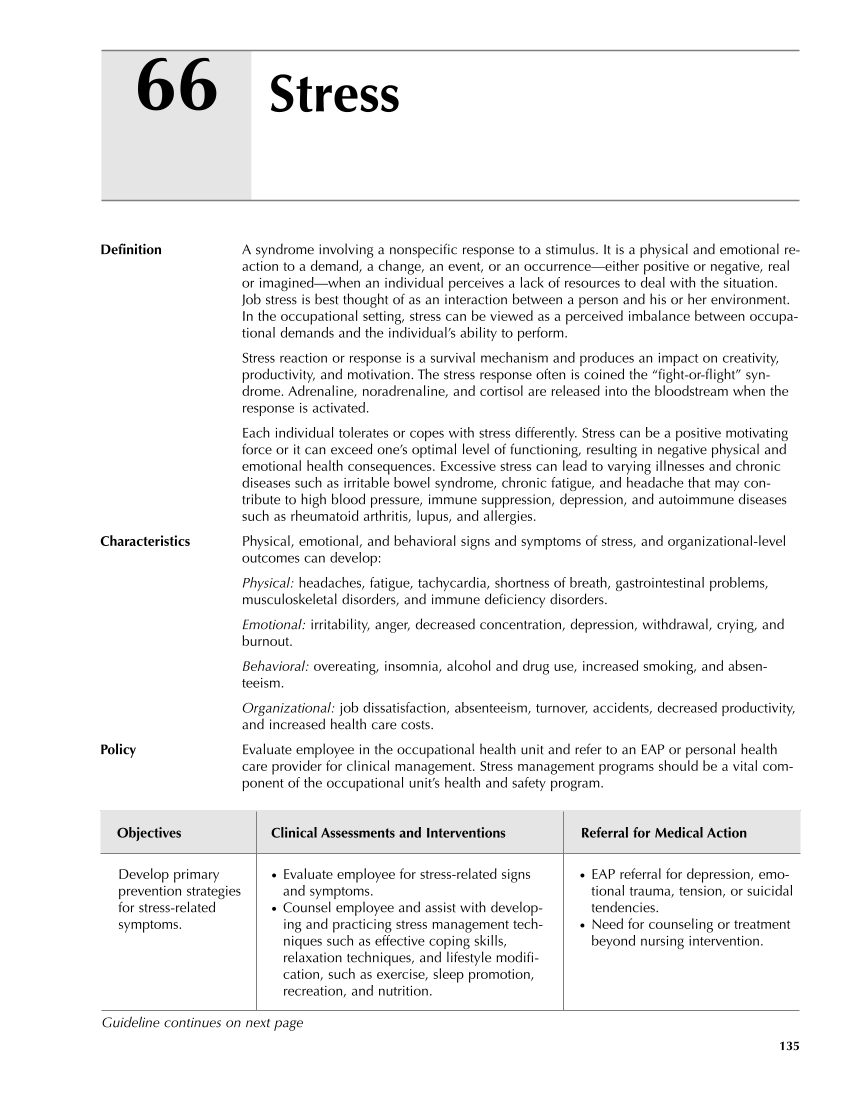135 Stress 66 Definition A syndrome involving a nonspecific response to a stimulus. It is a physical and emotional re- action to a demand, a change, an event, or an occurrence—either positive or negative, real or imagined—when an individual perceives a lack of resources to deal with the situation. Job stress is best thought of as an interaction between a person and his or her environment. In the occupational setting, stress can be viewed as a perceived imbalance between occupa- tional demands and the individual’s ability to perform. Stress reaction or response is a survival mechanism and produces an impact on creativity, productivity, and motivation. The stress response often is coined the “fight-or-flight” syn- drome. Adrenaline, noradrenaline, and cortisol are released into the bloodstream when the response is activated. Each individual tolerates or copes with stress differently. Stress can be a positive motivating force or it can exceed one’s optimal level of functioning, resulting in negative physical and emotional health consequences. Excessive stress can lead to varying illnesses and chronic diseases such as irritable bowel syndrome, chronic fatigue, and headache that may con- tribute to high blood pressure, immune suppression, depression, and autoimmune diseases such as rheumatoid arthritis, lupus, and allergies. Characteristics Physical, emotional, and behavioral signs and symptoms of stress, and organizational-level outcomes can develop: Physical: headaches, fatigue, tachycardia, shortness of breath, gastrointestinal problems, musculoskeletal disorders, and immune deficiency disorders. Emotional: irritability, anger, decreased concentration, depression, withdrawal, crying, and burnout. Behavioral: overeating, insomnia, alcohol and drug use, increased smoking, and absen- teeism. Organizational: job dissatisfaction, absenteeism, turnover, accidents, decreased productivity, and increased health care costs. Policy Evaluate employee in the occupational health unit and refer to an EAP or personal health care provider for clinical management. Stress management programs should be a vital com- ponent of the occupational unit’s health and safety program. Objectives Clinical Assessments and Interventions Referral for Medical Action ● EAP referral for depression, emo- tional trauma, tension, or suicidal tendencies. ● Need for counseling or treatment beyond nursing intervention. Develop primary prevention strategies for stress-related symptoms. ● Evaluate employee for stress-related signs and symptoms. ● Counsel employee and assist with develop- ing and practicing stress management tech- niques such as effective coping skills, relaxation techniques, and lifestyle modifi- cation, such as exercise, sleep promotion, recreation, and nutrition. Guideline continues on next page
Purchased from OEM Press by (ge corporate access). (C) 2013 OEM Health Information, Inc. All rights reserved.












































































































































































































































































































































































































































